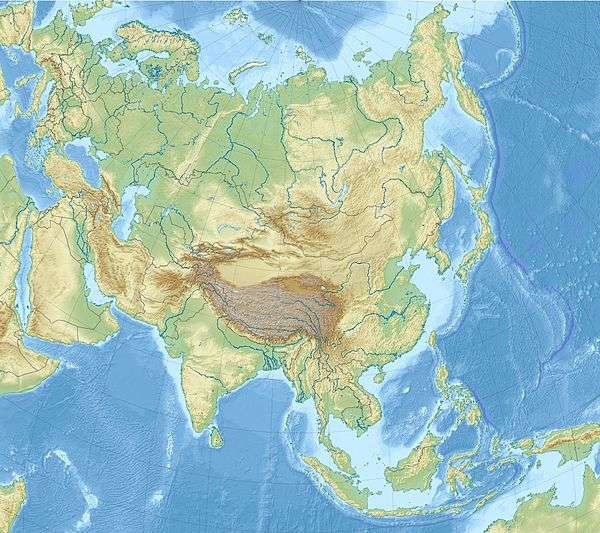Lake Chagan
Lake Chagan (Kazakh: Шаған, Shaǵan), or Lake Balapan, is a lake in Kazakhstan created by the Chagan nuclear test on January 15, 1965, which was conducted as part of the Soviet Union's Nuclear Explosions for the National Economy program. A 140 kiloton device was placed in a 178-metre-deep (584 ft) hole in the dry bed of the Chagan River. The blast created a crater 400 m (1,300 ft) across and 100 m (330 ft) deep with a lip height of 20 to 38 m (66 to 125 ft); it is often referred to as "Atomic Lake".
| Lake Chagan | |
|---|---|
.jpg) | |
 Lake Chagan  Lake Chagan | |
| Coordinates | 49°56′7″N 79°0′30″E |
| Basin countries | Kazakhstan |
| Water volume | 10,000,000 m3 (8,100 acre⋅ft)[1] |
The lake's water comes from the Chagan River, a tributary of the Irtysh River. The crater lake's volume is approximately 10 million m3 (350 million cu ft).[1] To the south, the rim of the crater holds back the waters of a second reservoir.
Media
In Netflix's documentary series Dark Tourist (season 1 episode 4, "The Stans"), David Farrier visits and swims in Lake Chagan during his tour of Kazakhstan.
See also
- Sedan (nuclear test) – an American cratering detonation
- Pechora–Kama Canal – a proposed canal project involving nuclear excavation
- Lake Karachay – a natural lake highly contaminated by the dumping of high-level nuclear waste
- Volcanic crater lake – a body of water normally formed by volcanic or meteoric events
References
- "On the Soviet program for peaceful uses of nuclear weapons" (PDF). Lawrence Livermore National Laboratory. September 1, 2000. Archived from the original (pdf) on 2016-12-23.
- "On the Soviet nuclear program". Nuclear Weapon Archive.
- Ayunov, D. E.; et al. (July 2017). "Present thermal regime of Lake Atomic (Semipalatinsk test site)". Russian Geology and Geophysics. 58 (7): 864–867. doi:10.1016/j.rgg.2017.06.009.
External links
- "A documentary that visits the lake at around the 1 minute mark" (video). YouTube. Russia Today.
- "Lake Chagan map" – via Google Maps.